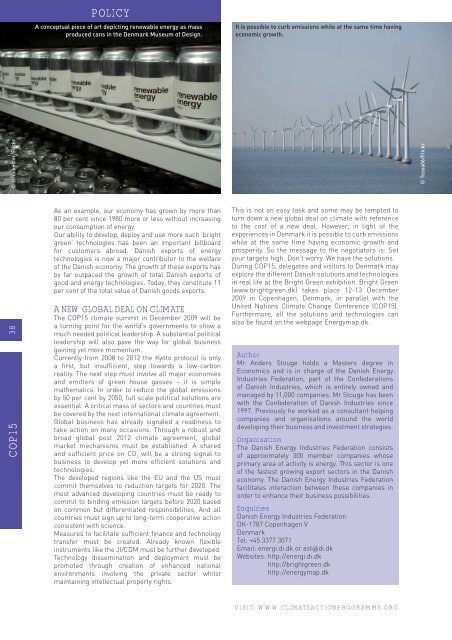Climate Action 2009-2010
Create successful ePaper yourself
Turn your PDF publications into a flip-book with our unique Google optimized e-Paper software.
POLICY<br />
A conceptual piece of art depicting renewable energy as mass<br />
produced cans in the Denmark Museum of Design.<br />
It is possible to curb emissions while at the same time having<br />
economic growth.<br />
The Middelgrunden offshore wind farm project located<br />
two kilometres off the city of Copenhagen’s coastline is a<br />
partnership between municipality and local shareholders.<br />
© sirmikester/Flickr<br />
© Tessa06/Flickr<br />
COP15 38<br />
As an example, our economy has grown by more than<br />
80 per cent since 1980 more or less without increasing<br />
our consumption of energy.<br />
Our ability to develop, deploy and use more such ‘bright<br />
green’ technologies has been an important billboard<br />
for customers abroad. Danish exports of energy<br />
technologies is now a major contributor to the welfare<br />
of the Danish economy. The growth of these exports has<br />
by far outpaced the growth of total Danish exports of<br />
good and energy technologies. Today, they constitute 11<br />
per cent of the total value of Danish goods exports.<br />
A NEW GLOBAL DEAL ON CLIMATE<br />
The COP15 climate summit in December <strong>2009</strong> will be<br />
a turning point for the world’s governments to show a<br />
much needed political leadership. A substantial political<br />
leadership will also pave the way for global business<br />
gaining yet more momentum.<br />
Currently from 2008 to 2012 the Kyoto protocol is only<br />
a first, but insufficient, step towards a low-carbon<br />
reality. The next step must involve all major economies<br />
and emitters of green house gasses – it is simple<br />
mathematics. In order to reduce the global emissions<br />
by 50 per cent by 2050, full scale political solutions are<br />
essential. A critical mass of sectors and countries must<br />
be covered by the next international climate agreement.<br />
Global business has already signaled a readiness to<br />
take action on many occasions. Through a robust and<br />
broad global post 2012 climate agreement, global<br />
market mechanisms must be established. A shared<br />
and sufficient price on CO 2<br />
will be a strong signal to<br />
business to develop yet more efficient solutions and<br />
technologies.<br />
The developed regions like the EU and the US must<br />
commit themselves to reduction targets for 2020. The<br />
most advanced developing countries must be ready to<br />
commit to binding emission targets before 2020 based<br />
on common but differentiated responsibilities. And all<br />
countries must sign up to long-term cooperative action<br />
consistent with science.<br />
Measures to facilitate sufficient finance and technology<br />
transfer must be created. Already known flexible<br />
instruments like the JI/CDM must be further developed.<br />
Technology dissemination and deployment must be<br />
promoted through creation of enhanced national<br />
environments involving the private sector whilst<br />
maintaining intellectual property rights.<br />
This is not an easy task and some may be tempted to<br />
turn down a new global deal on climate with reference<br />
to the cost of a new deal. However, in light of the<br />
experiences in Denmark it is possible to curb emissions<br />
while at the same time having economic growth and<br />
prosperity. So the message to the negotiators is: Set<br />
your targets high. Don’t worry. We have the solutions.<br />
During COP15, delegates and visitors to Denmark may<br />
explore the different Danish solutions and technologies<br />
in real life at the Bright Green exhibition. Bright Green<br />
(www.brightgreen.dk) takes place 12-13 December<br />
<strong>2009</strong> in Copenhagen, Denmark, in parallel with the<br />
United Nations <strong>Climate</strong> Change Conference (COP15).<br />
Furthermore, all the solutions and technologies can<br />
also be found on the webpage Energymap.dk.<br />
Author<br />
Mr Anders Stouge holds a Masters degree in<br />
Economics and is in charge of the Danish Energy<br />
Industries Federation, part of the Confederations<br />
of Danish Industries, which is entirely owned and<br />
managed by 11,000 companies. Mr Stouge has been<br />
with the Confederation of Danish Industries since<br />
1997. Previously he worked as a consultant helping<br />
companies and organisations around the world<br />
developing their business and investment strategies.<br />
Organisation<br />
The Danish Energy Industries Federation consists<br />
of approximately 300 member companies whose<br />
primary area of activity is energy. This sector is one<br />
of the fastest growing export sectors in the Danish<br />
economy. The Danish Energy Industries Federation<br />
facilitates interaction between these companies in<br />
order to enhance their business possibilities.<br />
Enquiries<br />
Danish Energy Industries Federation<br />
DK-1787 Copenhagen V<br />
Denmark<br />
Tel: +45 3377 3071<br />
Email: energi.di.dk or ast@di.dk<br />
Websites: http://energi.di.dk<br />
http://brightgreen.dk<br />
http://energymap.dk<br />
VISIT: WWW.C L IMATEAC T I O N P R O G RAMME.O R G












